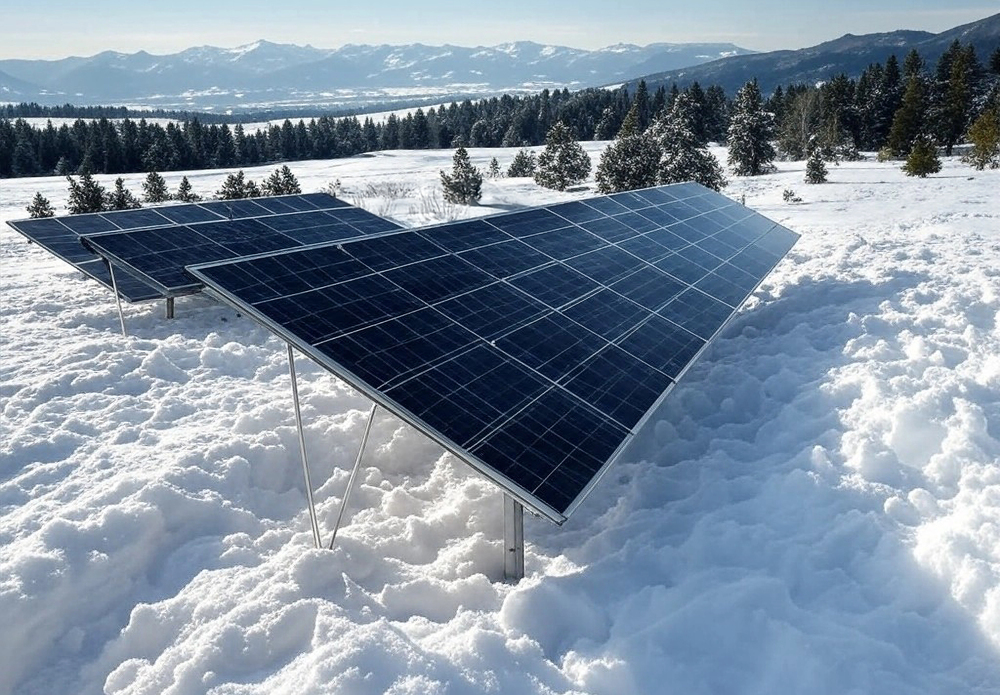Article at a glance
- Grid-tied energy systems help balance seasonal variations in production.
- Home battery systems complement wintertime renewable energy production.
- Snow coverage on solar panels does not wholly halt energy production.
- Reduced daylight hours and cloud cover can affect winter solar performance.
You might worry that investing in solar energy isn’t worthwhile if you live in an area with cold winters and frequent snowfall. However, solar panels can work in winter. Renewable energy technology is advanced and has proven highly effective even in challenging weather conditions.
In this guide, Navigate Power shares how this renewable energy system performs during winter and why it remains a reliable energy solution year-round.
How Do Solar Panels Work in Winter?
When sunlight hits the photovoltaic cells, it creates an electric current regardless of the temperature. These panels often perform more efficiently in cold weather because electrons rest in lower temperatures, creating a more significant voltage difference when activated by sunlight.
Panel efficiency typically improves in temperatures below 77°F, while higher temperatures can reduce system efficiency by up to 20%. If sunlight reaches the panels, your equipment can generate significant power even on the coldest days.
Even cloudy days contribute to solar energy production through diffuse light. The panels can still capture scattered sunlight that penetrates through cloud cover. Rain and snow can help maintain panel efficiency by washing away dust and debris that might otherwise reduce performance.
Winter storms and snow generally don’t damage panel installations. Modern systems undergo rigorous testing to withstand extreme weather conditions, including heavy snow loads and freezing temperatures.
Common Misconceptions About Solar Efficiency in Cold Weather
Many people believe that low temperatures negatively impact solar panel performance. However, scientific evidence shows that the opposite is often true. Light intensity matters more than temperature in solar energy production.
Research from leading institutions demonstrates that panels can achieve peak efficiency in temperatures as low as -40°F. Cold climates like Massachusetts, New Jersey, and New York consistently rank among the top ten states for sustainable energy installations.
Additional Read: How Sustainable Energy Consultants Can Help Businesses Reduce Their Carbon Footprint
Here are some of the most common myths about wintertime solar energy usage you may have heard:
- They only work in warm climates
- Winter weather automatically means poor performance
- Cold temperatures reduce panel efficiency
- Snow makes panels completely ineffective
- Panels require constant maintenance in wintertime
- Cloud cover completely stops energy production
- Cold weather damages the equipment
It might surprise you to learn that solar panels continue working in winter. Northern states often see greater annual savings from renewable energy installations due to higher electricity rates and increased solar panel efficiency in cold weather. The technology continues to advance, with modern panels featuring improved cold-weather performance and enhanced durability for harsh weather conditions.
Grid-tied energy systems help balance seasonal variations in production. These panels generate excess power during long summer days, earning credits that offset reduced winter production. This net metering arrangement ensures consistent energy savings throughout the year, regardless of seasonal changes.
Additional Read: Choosing the Best Energy Source for Your Business
Home battery systems perfectly complement wintertime renewable energy production. Energy storage solutions allow you to bank excess electrical power during shorter winter days or weather-related grid outages. This combination provides reliable renewable energy even during the most challenging winter conditions.
Do Solar Panels Still Work If Covered in Snow?
The answer to this question is a resounding yes because snow coverage on these panels doesn’t completely halt energy production. While heavy snow accumulation can temporarily reduce output, several factors help maintain functionality:
- Panels are typically installed at an angle, allowing snow to slide off naturally
- Dark panel surfaces absorb heat and help melt snow
- Snow’s reflective properties can increase energy production through the “albedo effect”
- Light can still penetrate through thin layers of snow
The Effect of Shorter Winter Days on Electrical Output
Shorter sunlight hours during winter naturally affect solar panel production. However, modern systems account for seasonal variations in their annual energy calculations.
Key factors that influence winter solar performance:
- Reduced daylight hours
- Sun angle and intensity
- Cloud cover frequency
- Regional weather patterns
Maintenance Tips for Optimizing Winter Solar Performance
Proper maintenance for any solar panel working in winter is essential for optimal energy output. Focus on these key tasks:
- Monitor system performance regularly
- Keep panels clear of debris
- Check for ice dam formation
- Ensure proper system tilt for snow-shedding
- Consider professional maintenance checks in the fall
Most panels are self-cleaning and don’t require hands-on maintenance during winter. The dark, reflective glass surfaces absorb heat and accelerate snowmelt, while typical installation angles of 30 to 45 degrees allow snow to slide off. Using snow rakes or attempting to clear snow manually can damage panels and void warranties.
Weather monitoring helps optimize yearlong performance. Track local weather forecasts to anticipate snowfall and prepare for potential production changes. Understanding weather patterns helps you make informed decisions about energy usage and storage during winter.
Professional solar panel installers recommend against climbing onto snowy roofs to clear panels. Instead, focus on ground-level maintenance, such as trimming overhanging branches that could drop snow onto panels or checking that roof drainage systems remain clear. Your safety matters more than gaining a few extra hours of winter production.
Benefits of Installing Solar Systems in Winter
With solar panels working in winter, you might wonder whether installations are possible at any time of year. Winter installation offers several advantages for homeowners, including:
- Potentially lower installation costs
- Shorter wait times for installation
- System ready for peak summer production
- Better energy independence during winter storms
- Immediate savings on winter energy bills
The Importance of Energy Storage Solutions
Battery storage systems become particularly valuable during the coldest months. They help maintain the power supply during the following:
- Short winter days
- Extended cloudy periods
- Grid outages from winter storms
- Peak evening usage times
- Emergencies
Experience Solar Success With Navigate Power
Solar panels working in winter means you can be confident in your energy future decisions. Your renewable energy investment can provide reliable power throughout the year, regardless of season or weather conditions.
We at Navigate Power specialize in designing solar systems optimized for all climate conditions across our service area. Ready to explore how sustainable energy can work for you this winter? Contact Navigate Power at (800) 541-1137 to discuss solar solutions available in all 50 states.



